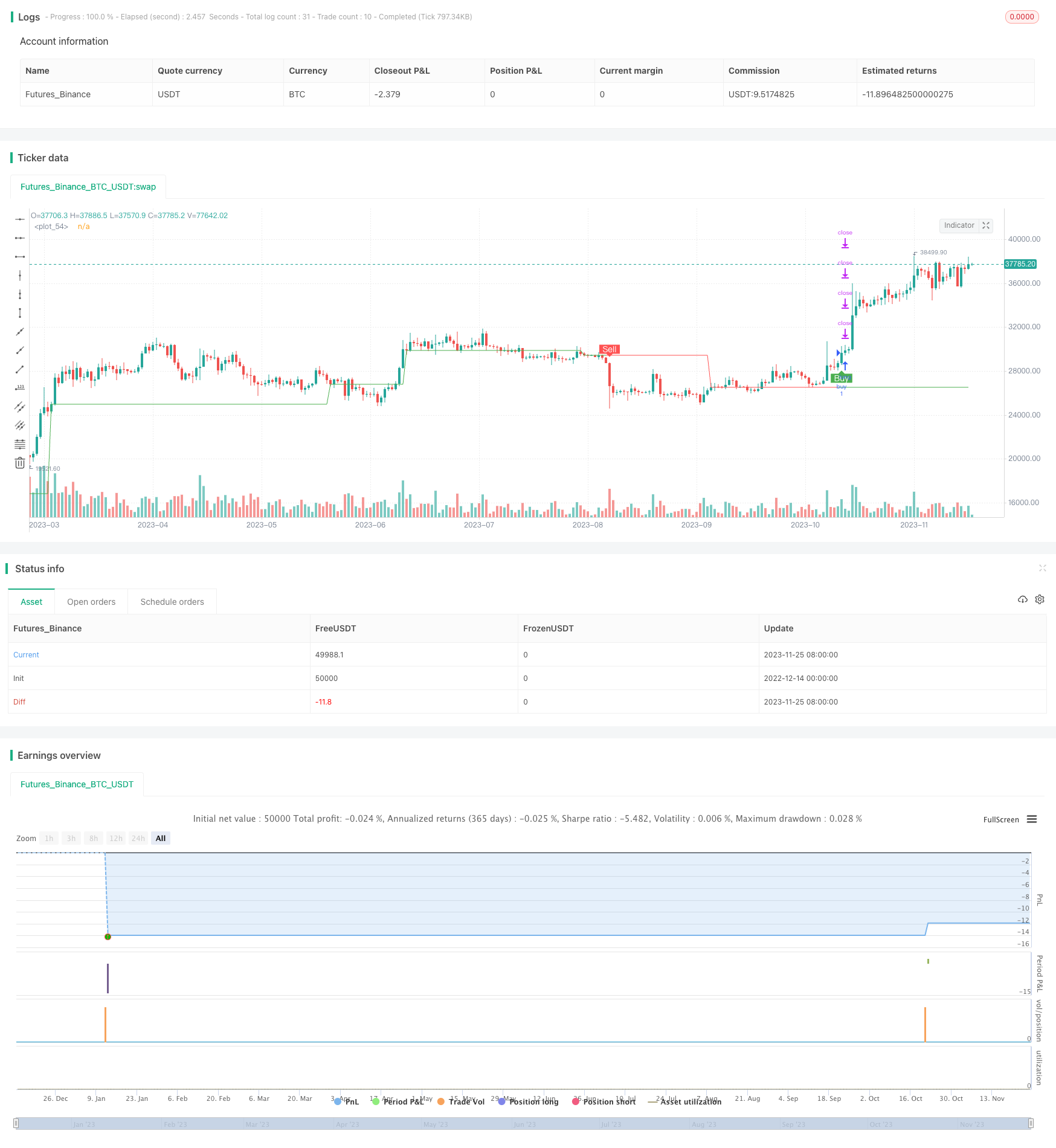
概述
本策略结合了相对强弱指标(TRSI)和超级趋势指标(SUPER Trend),形成一套较为完整的量化交易策略。策略主要用于捕捉中长线趋势,同时利用短期指标过滤噪音交易信号。
策略原理
- 计算TRSI指标判断市场是否处于超买超卖状态,发出买入卖出信号
- 使用SUPER Trend指标过滤噪音信号,确认基本面趋势
- 在获利盘中的不同阶段设置止损止盈点
具体来说,策略首先计算TRSI指标,判断市场是否出现超卖区域,然后计算SUPER Trend指标判断大趋势方向。结合二者发出交易信号。之后设置止损止盈点,在不同阶段盈利回撤不同比例资金。
优势分析
本策略有以下几个优势:
- 多指标组合,提高信号准确率。TRSI判断时点,SUPER Trend过滤方向。
- 适用于中长线趋势交易。超买超卖信号容易形成趋势反转。
- 止损止盈设置合理,不同阶段盈利回撤不同比例资金,有效控制风险。
风险分析
本策略也存在一些风险:
- 中长线交易,无法捕捉短线交易机会。
- TRSI参数设置不当,可能错过超买超卖区间。
- SUPER Trend参数设置不当,可能发出错误信号。
- 止损空间过大,无法有效控制风险。
针对这些风险,我们可以从以下几个方面进行优化:
优化方向
- 结合更多短线指标,识别更多交易机会。
- 调整TRSI参数,缩小误差区间。
- 测试并优化SUPER Trend参数。
- 设定浮动止损,实时跟踪止损线。
总结
本策略综合运用TRSI和SUPER Trend等多个指标,形成较为完整的量化交易策略。可有效识别中长线趋势,同时设置止损止盈控制风险。策略优化空间还很大,后续可从提高信号准确率、识别更多交易机会等方面进行改进。总体来说,这是一个较好的量化策略起点。
策略源码
/*backtest
start: 2022-12-14 00:00:00
end: 2023-11-26 05:20:00
period: 1d
basePeriod: 1h
exchanges: [{"eid":"Futures_Binance","currency":"BTC_USDT"}]
*/
//@version=4
strategy(title = "SuperTREX strategy", overlay = true)
strat_dir_input = input(title="Strategy Direction", defval="long", options=["long", "short", "all"])
strat_dir_value = strat_dir_input == "long" ? strategy.direction.long : strat_dir_input == "short" ? strategy.direction.short : strategy.direction.all
strategy.risk.allow_entry_in(strat_dir_value)
length = input( 14 )
overSold = input( 35 )
overBought = input( 70 )
HTF = input("W", type=input.resolution)
ti = change( time(HTF) ) != 0
p = fixnan( ti ? close : na )
vrsi = rsi(p, length)
price = close
var bool long = na
var bool short = na
long :=crossover(vrsi,overSold)
short := crossunder(vrsi,overBought)
var float last_open_long = na
var float last_open_short = na
last_open_long := long ? close : nz(last_open_long[1])
last_open_short := short ? close : nz(last_open_short[1])
entry_value =last_open_long
entry_value1=last_open_short
xy=(entry_value+entry_value)/2
// INPUTS //
st_mult = input(4, title = 'SuperTrend Multiplier', minval = 0, maxval = 100, step = 0.01)
st_period = input(10, title = 'SuperTrend Period', minval = 1)
// CALCULATIONS //
up_lev =xy - (st_mult * atr(st_period))
dn_lev =xy + (st_mult * atr(st_period))
up_trend = 0.0
up_trend := entry_value[1] > up_trend[1] ? max(up_lev, up_trend[1]) : up_lev
down_trend = 0.0
down_trend := entry_value1[1] < down_trend[1] ? min(dn_lev, down_trend[1]) : dn_lev
// Calculate trend var
trend = 0
trend := close > down_trend[1] ? 1: close < up_trend[1] ? -1 : nz(trend[1], 1)
// Calculate SuperTrend Line
st_line = trend ==1 ? up_trend : down_trend
plot(xy,color = trend == 1 ? color.green : color.red)
buy=crossover( close, st_line)
sell1=crossunder(close, st_line)
buy1=buy
//
sell=sell1
// STRATEGY
plotshape(buy , title="buy", text="Buy", color=color.green, style=shape.labelup, location=location.belowbar, size=size.small, textcolor=color.white, transp=0) //plot for buy icon
plotshape(sell, title="sell", text="Sell", color=color.red, style=shape.labeldown, location=location.abovebar, size=size.small, textcolor=color.white, transp=0) //plot for sell icon
// Take profit
//
l = buy
s1=sell
if l
strategy.entry("buy", strategy.long)
if s1
strategy.entry("sell", strategy.short)
per(pcnt) => strategy.position_size != 0 ? round(pcnt / 100 * strategy.position_avg_price / syminfo.mintick) : float(na)
stoploss=input(title=" stop loss", defval=25, minval=0.01)
los = per(stoploss)
q1=input(title=" qty_percent1", defval=25, minval=1)
q2=input(title=" qty_percent2", defval=25, minval=1)
q3=input(title=" qty_percent3", defval=25, minval=1)
tp1=input(title=" Take profit1", defval=2, minval=0.01)
tp2=input(title=" Take profit2", defval=4, minval=0.01)
tp3=input(title=" Take profit3", defval=6, minval=0.01)
tp4=input(title=" Take profit4", defval=8, minval=0.01)
strategy.exit("x1", qty_percent = q1, profit = per(tp1), loss = los)
strategy.exit("x2", qty_percent = q2, profit = per(tp2), loss = los)
strategy.exit("x3", qty_percent = q3, profit = per(tp3), loss = los)
strategy.exit("x4", profit = per(tp4), loss = los)